Proof of Work (PoW) stands as the bedrock of many cryptocurrencies, including Bitcoin, providing the security and consensus mechanism that allows these decentralized systems to function without a central authority. While its energy-intensive nature has sparked debate, understanding PoW is crucial for grasping the fundamentals of blockchain technology and its underlying principles. This post will delve into the intricacies of Proof of Work, exploring its mechanics, security aspects, and its role in securing digital assets.
Understanding Proof of Work
Proof of Work (PoW) is a consensus mechanism used to validate transactions and add new blocks to a blockchain. It involves solving a complex computational puzzle, which requires significant processing power and energy. The miner who successfully solves the puzzle gets to add the next block to the chain and receives a reward in the form of newly minted cryptocurrency and transaction fees.
How Proof of Work Functions
- Transaction Broadcasting: When a transaction occurs on the network, it’s broadcast to all nodes (computers) participating in the blockchain.
- Block Creation: Miners gather pending transactions into a block.
- Puzzle Solving: Miners then compete to solve a computationally difficult puzzle, which involves finding a nonce (an arbitrary number) that, when combined with the block data and hashed using a cryptographic function (like SHA-256), produces a hash that meets a specific target difficulty. This target difficulty is dynamically adjusted to maintain a consistent block creation time.
- Block Validation: Once a miner finds a valid nonce and creates a hash that meets the target, they broadcast the block to the network. Other nodes verify the solution and, if valid, add the block to their copy of the blockchain.
- Reward Distribution: The miner who successfully solved the puzzle is rewarded with a predetermined amount of cryptocurrency and any transaction fees associated with the transactions in the block.
Practical Example: Bitcoin Mining
Bitcoin is the most well-known cryptocurrency that utilizes Proof of Work. Bitcoin miners use specialized hardware (ASICs) to perform the hashing calculations required to solve the puzzle. The difficulty of the puzzle is adjusted roughly every two weeks to maintain an average block creation time of approximately 10 minutes. This adjustment ensures the stability and predictability of the Bitcoin network.
Security Aspects of Proof of Work
Proof of Work provides a high level of security against malicious attacks by making it computationally expensive to alter the blockchain. The amount of computational power required to rewrite the blockchain makes it economically infeasible for attackers to succeed.
51% Attack
- The most significant threat to PoW blockchains is a 51% attack. This occurs when a single entity or group controls more than 50% of the network’s hashing power. With this control, they could potentially manipulate transactions, censor others’ transactions, or double-spend their own coins.
- However, launching a successful 51% attack on a large blockchain like Bitcoin is extremely expensive due to the immense computational resources required. The cost of acquiring and maintaining such a large amount of hardware and energy often outweighs the potential benefits of the attack.
Immutability and Tamper-Resistance
- Proof of Work ensures the immutability and tamper-resistance of the blockchain. Once a block is added to the chain, it becomes extremely difficult to alter it without redoing all subsequent blocks, which would require an attacker to control a significant portion of the network’s hashing power.
- The distributed nature of the blockchain also contributes to its security. Copies of the blockchain are stored on numerous nodes across the network, making it difficult for attackers to corrupt the entire system.
Energy Consumption and Environmental Concerns
Proof of Work is known for its high energy consumption. The intensive computational power required for mining necessitates a significant amount of electricity, which has raised concerns about its environmental impact.
Energy Sources and Sustainability
- The environmental impact of PoW depends largely on the energy sources used by miners. Some miners utilize renewable energy sources, such as solar, wind, and hydroelectric power, to reduce their carbon footprint.
- There is a growing trend toward more sustainable mining practices, driven by increased environmental awareness and the availability of cheaper renewable energy options.
Alternatives to Proof of Work
- Several alternative consensus mechanisms have been developed to address the energy consumption issues associated with Proof of Work. These include Proof of Stake (PoS), Delegated Proof of Stake (DPoS), and Proof of Authority (PoA).
- Proof of Stake, for example, requires users to stake a certain amount of cryptocurrency to become validators, and the probability of being selected to validate a block is proportional to the amount of cryptocurrency staked. This eliminates the need for energy-intensive mining.
The Future of Proof of Work
While Proof of Work faces challenges related to energy consumption, it remains a widely used and highly secure consensus mechanism. Its long track record and proven resistance to attacks make it a reliable choice for securing blockchain networks.
Ongoing Improvements and Innovations
- Researchers and developers are constantly working on improvements to Proof of Work to make it more energy-efficient and scalable.
- One approach is to use more efficient hardware and algorithms to reduce energy consumption. Another is to explore hybrid consensus mechanisms that combine Proof of Work with other mechanisms to improve performance and reduce energy use.
Coexistence with Other Consensus Mechanisms
- It is likely that Proof of Work will continue to coexist with other consensus mechanisms in the future. Different blockchains may choose different consensus mechanisms based on their specific needs and priorities.
- Some blockchains may even adopt hybrid approaches, combining the strengths of multiple consensus mechanisms to create a more robust and efficient system.
Conclusion
Proof of Work has played a pivotal role in the development and growth of cryptocurrencies, providing a secure and reliable way to validate transactions and maintain the integrity of blockchain networks. While its energy consumption remains a concern, ongoing efforts to improve its efficiency and explore sustainable energy sources could help mitigate its environmental impact. As the blockchain landscape continues to evolve, Proof of Work is likely to remain a significant consensus mechanism, coexisting with other innovative approaches to securing digital assets.




